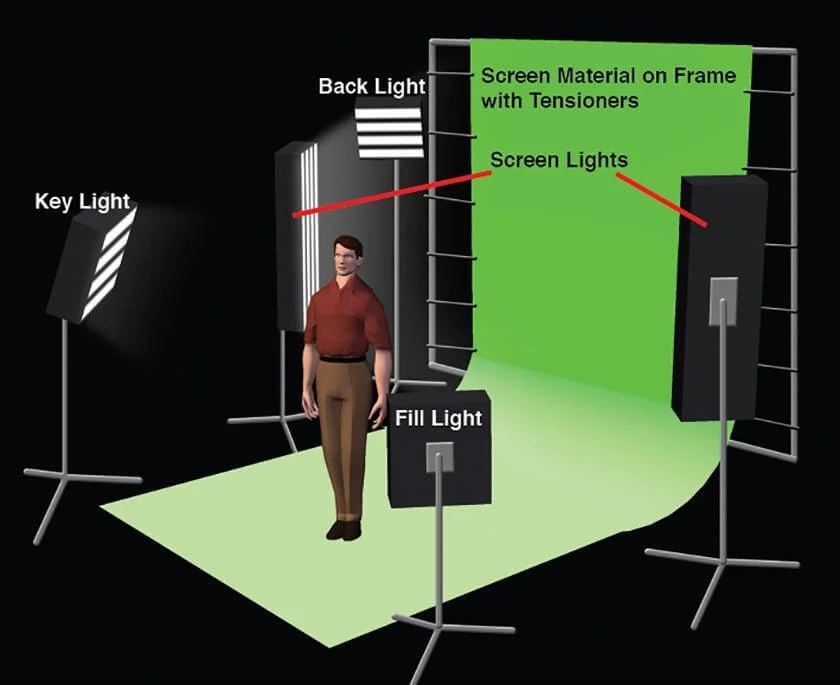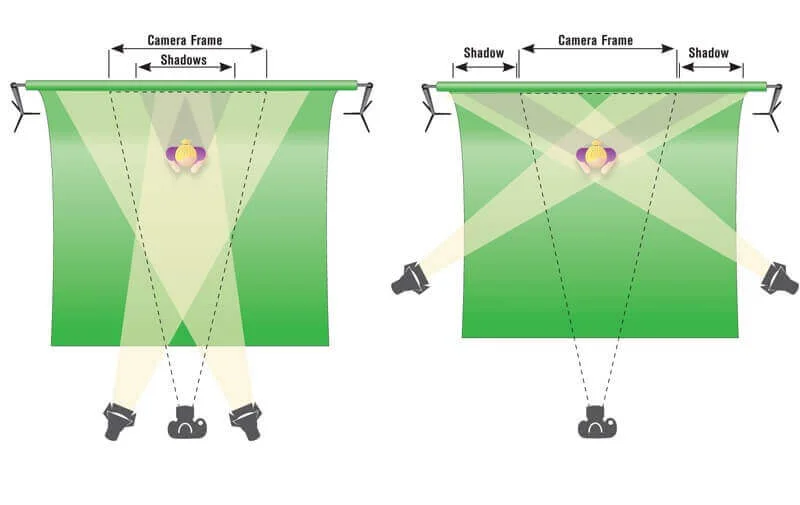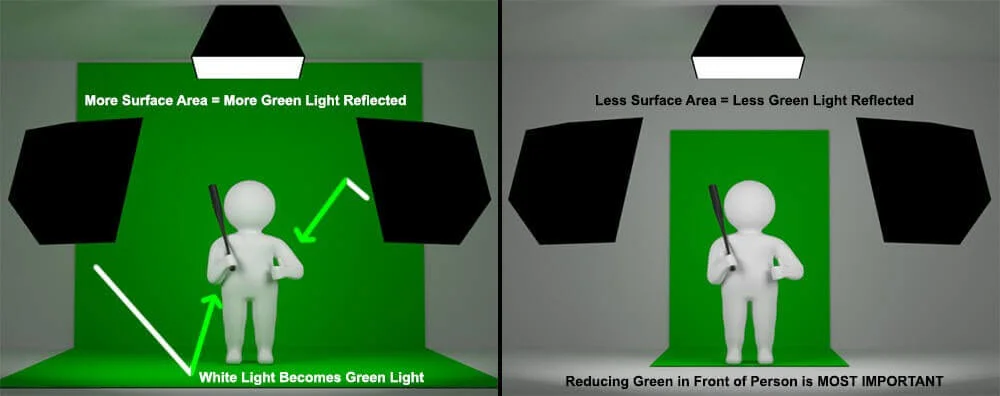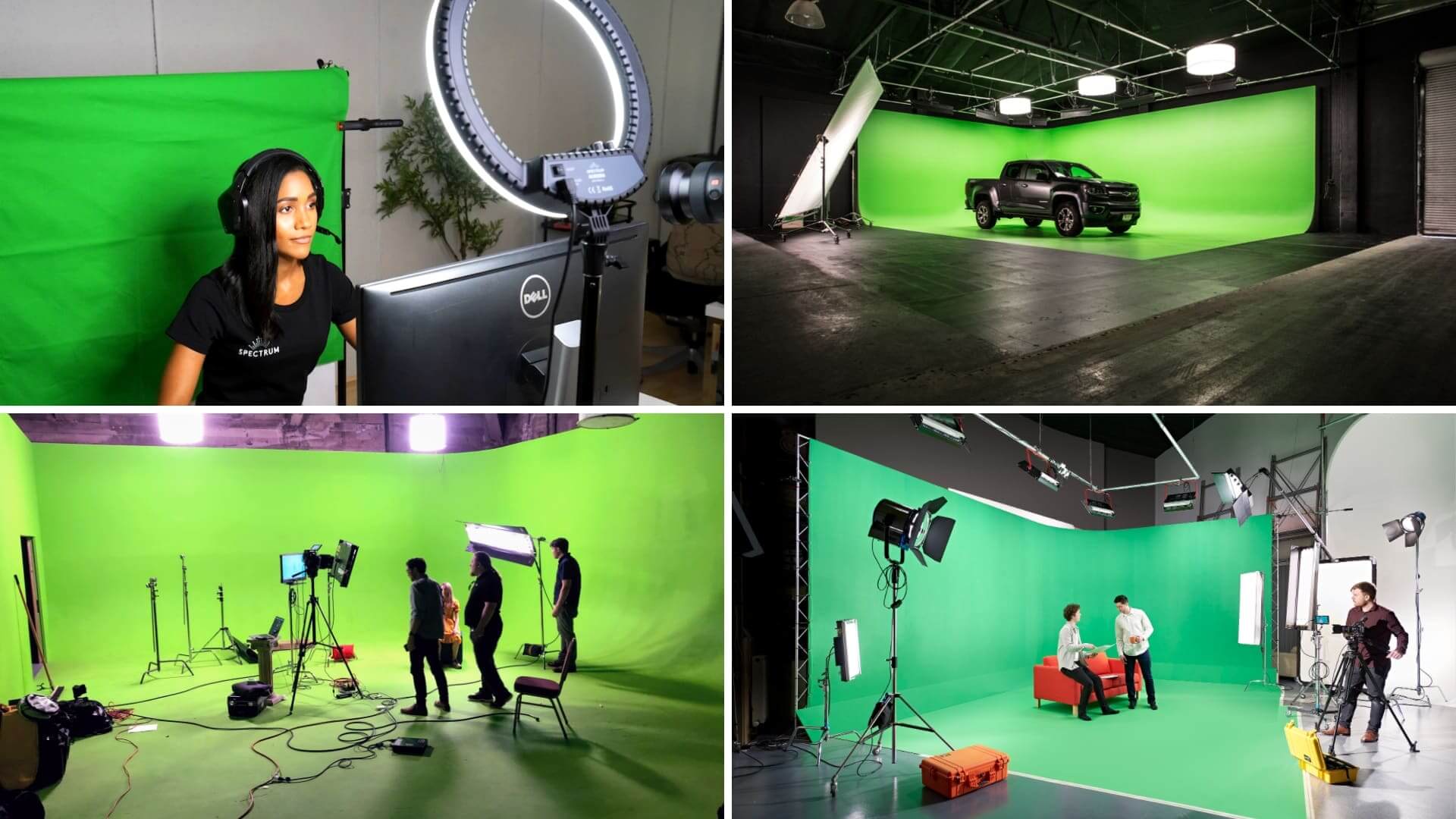In filmmaking, the phrase, “We’ll fix it in post” gets thrown around a lot. While working with a green screen requires a lot of post production work, it’s all for naught if you don’t light the scene properly. A green screen opens up a whole new world of possibilities for your next project. If you plan on using one, then you need our guide on correct green screen lighting to ensure your chroma key shots don’t look like a $10 commercial.
BEST LIGHTS FOR GREEN SCREEN
Importance of green screen lighting
Chroma keying is a valuable tool in your VFX kit. Using a green screen is pretty straightforward, especially when you understand the chroma key process, but you want to make sure you have the right lights to go with your backdrop.
Chances are you’ve spotted bad VFX throughout your film career. Slow shutter speed and improper color balance can play a role, but you also want to look at your green screen lighting setup.
Bad green screen and lights result in an uneven tone on camera. Some areas look darker than others. The darker areas become harder to chroma key out afterward. This is especially true if there are transparent objects or fine hair within the shot.
Why You Can Spot Bad Green Screen • Tom Scott
The first tip on green screen lighting is to make sure the subject of the shot is far away enough to avoid light leaks from the green screen. You must also light the green screen and subject separately to give your post-production staff the easiest time later.
And even if you have a DIY green screen and inexpensive lights, you can still achieve the best green screen match lighting possible. Just follow our lead and a few simple chroma key lighting tips, and your backgrounds won’t look like they belong in a Spy Kids movie from 2003.
LIGHTING A GREEN SCREEN TUTORIAL
How to light a green screen
While your exact lighting rig will vary depending on several factors, here’s a diagram of the basic set-up you want for optimal chroma screen lighting. Notice the subject and screen are being lit separately.

Green Screen Lighting Setup Diagram • StudioBinder
But how do you go from nothing to our beautiful diagram above? That’s easy. This video shows how you can get the best green screen lighting setup in just four minutes. A few easy steps are all it takes.
How to Light a Green Screen in 4 Minutes • Aputure
Set up the green screen equipment
Whether you have a cheap green screen lighting kit or something that rivals most blockbusters, you want to get that situated first. You should smooth out the material if you have a fabric or paper green screen.
A good rule of thumb is to avoid any reflective materials in the shot. Jewelry and glasses can complicate this. If you know you need a green screen for a given shot, then you should keep tabs of what props are necessary and adjust as needed.
Get the same lights
As you can see from the diagram, you want two lights directed right at the green screen. We recommend Diva 400s, which are Kino Flo fluorescent lights, for best results. But if you want to know how to light a green screen for cheap, then you can opt for some clamp lights and fluorescent bulbs from Home Depot for about $10 each.
Ultimately, it doesn’t matter a great deal what specific lights you get. You just want to make sure they’re exactly the same. Different lights have varying color temperatures. This leads to an uneven color balance.
Light the subject first
After you acquire all of your green screen lighting, you may be ready to get that perfect shade. But before you focus on the green screen itself, you want to make sure the subjects of the shot are properly lit.
In general, your subject should be about eight feet away from the green screen. To light them, you’re going to need the following lights.
- Key light: The key light is the predominant light source for the subject. It should match wherever the light source (i.e. the sun, other lights in a building) would naturally be.
- Back light: The back light creates a soft halo effect in the subject’s hair. Mostly used when the subject should be in a studio setting.
- Fill light: The fill light creates ambiance within the scene and helps soften shadows created by the key light.
You may need to adjust the setup from our diagram slightly. For example, you may need more fill lights depending on the kind of shot you want. That’s okay! But that’s why you need to deal with the subject first. If you light the green screen first, then you may need to change it later based off what your subject needs to do. Then you’ve wasted a bunch of time for nothing.
Light the green screen
Once you have your subject the way you want them, it’s time to position the lights to target the green screen. Each light should be the same distance away and at the same angle. This is the best way to ensure an even lighting across.
You'll notice in these two diagrams that Setup #1 (left) will cast shadows from the subject, while Setup #2 (right) keeps the shadows outside the camera's field of view.

How to Light a Green Screen With Two Lights • StudioBinder
While you can play with different angles, it’s generally a good idea to keep your two green screen lights in a similar position to the right-hand image above. That way the camera doesn’t capture any shadow behind the subject. The shadows instead appear off to the side, away from the camera’s view. All you’re left with is solid green, which is why it’s typically the best lighting for the chroma key later.
Expose the green screen correctly
Finally, you want to examine your camera monitor for the exposure. This is how much light your camera takes in. You want a little less brightness than normal so that you don’t capture colors outside of green.
It’s also a good idea to lower your camera’s ISO setting. Sometimes, random specks of color appear in your shot, but you reduce this by lowering the ISO. But make sure not to lower the ISO too much as this can underexpose the green screen and lead to other problems.
Once you adjust your camera, you may find you need to alter a few lights. Go ahead and do that as it saves you a ton of hassle later.
Once everything looks good and you have an even green shade across the screen, you’re ready to start filming.
Related Posts
HOW TO LIGHT A GREEN SCREEN FOR VIDEO
Green screen lighting tips
It seems pretty easy. Just set up a few lights and get filming. But in your excitement over the scene, it’s easy to overlook some of the basics of green screen filmmaking. Here are a couple of green screen tips to keep in mind to ensure your scene comes out as good as possible.
Opt for a smaller green screen if possible
Three point lighting for a green screen can provide some stellar shots. But it can also result in leaks onto your subject. Refer to this diagram.

How to Light for a Green Screen • StudioBinder
The more surface area you have, the more green light gets reflected. This is especially important if you have a close-up on a single person. You don’t need a huge screen behind them. This also saves you on costs because you can get a smaller screen or smaller piece of fabric to make your green screen. Either way, less tends to be better.
Understand your camera inside and out
Modern cameras are incredibly light sensitive. That means you may not require as much light to make your green screen backdrop looks its best as you might think.
You should look into raising your camera’s light sensitivity or ISO. Even if you can’t afford the best lights, your camera may be able to pick up the slack. Check out some of the best video cameras on the market to see if any suit your fancy. And play around with different settings before the big shoot arrives.
Fix in post if necessary
We said to avoid fixing things in post. And you really should do everything in your power to light a green screen properly so that you don’t have to fix it later. However, mistakes happen.
You may not realize until days later as you’re editing that there are shadows on your green screen. It’s a lot more work, but there are ways to fix a poorly-lit green screen in Premiere Pro.
How to Get the Perfect Green Screen Even With Bad Lighting • Loco Coco
While you can fix an uneven green screen in post, it’s difficult and time-consuming. It only takes a few minutes to set up lights the right way. It could take hours to color correct. Save yourself the hassle and get the right lights for your green screen.
A green screen can be the perfect tool in your filmmaker’s arsenal. And with proper lighting, you can incorporate unique scenes into your next project with ease.
Related Posts
UP NEXT
Best Green Screen Backgrounds
You attained the perfect green screen lighting. Now what? It’s time to find something to fill in all of that green. And luckily, there are numerous sites where you can find green screen backgrounds for free or affordably. The right background takes your actor from a basement to a magical kingdom. And you have numerous options to choose from.
Up Next: Green Screen Backgrounds→
Showcase your vision with elegant shot lists and storyboards.
Create robust and customizable shot lists. Upload images to make storyboards and slideshows.
